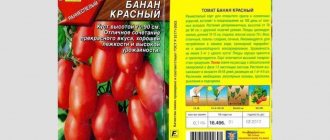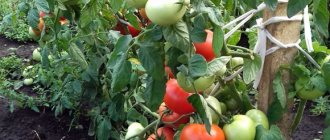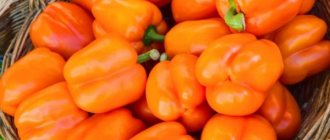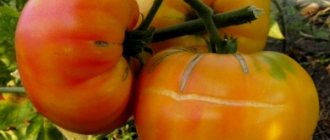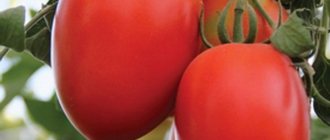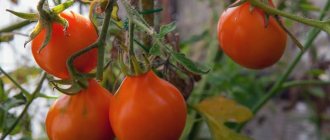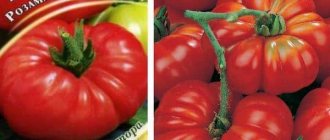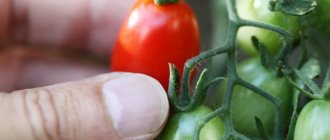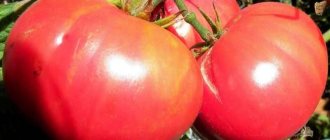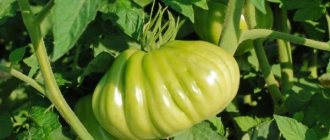The problem of seed germination and growing seedlings affects not only novice gardeners, but also experienced summer residents. Very often, even experienced gardeners may encounter the problem that seedlings have very poor growth or the seeds do not hatch. In some cases, the reason lies in the quality of the seeds or soil, but more often than not, tomato seedlings grow poorly due to improper temperature conditions. By following a few rules and controlling the temperature, you can grow strong seedlings that will delight you with their harvest even in late autumn. Maintaining a certain temperature regime will stimulate seed germination and ensure the growth of the root system.
How does temperature affect when growing tomato seedlings?
Because tomatoes are heat-loving plants, then low and high temperatures that do not meet the requirements are destructive for the tomato at all stages of its growth, from seedlings to the fruiting period. If the temperature regime is violated, the development of diseases in seedlings is observed - they stretch out or do not grow at all, the seeds die in the soil, the yield of adult plants decreases, and the fruits are underdeveloped. Read about growing Indian onions at home here.
How to warm it up at home
Like hardening, heating seeds gives higher germination rates and yields. In this way we develop resistance to sudden changes in air temperature. To do this, just put the seeds in a warm place, for example, on a radiator with a temperature of 45-55 degrees or under an ultraviolet lamp. Warming up usually lasts 2-3 days. It is very important that the temperature rises gradually.
Another way is to heat the seeds in the oven. To do this, you need to scatter them evenly on a baking sheet and bake for 3 hours at a temperature of 60 degrees, while stirring regularly.
Seed producers categorically do not recommend warming up hybrid varieties, as this impairs germination and can negatively affect the amount of harvest.
Why hardening is needed
One way to adapt any tomato variety to climatic conditions is hardening. It is noted that such seedlings bloom several days earlier and bear 30-50% more fruit. This is done as follows:
- For pre-sowing treatment of seeds, they are stored for 12 hours in the refrigerator, where the temperature is -1-0 degrees.
- After 12 hours, the seeds are taken to a warm place and left for a day.
- The procedure is repeated several times to achieve maximum effect.
Is it necessary to germinate and how is germination done?
One of the most controversial issues for gardeners is the need to germinate seeds. Germination is carried out from dry and selected seeds over several days. The container is lined with fabric or cotton wool, on which the seeds prepared in advance are then placed. They are filled with warm liquid and placed in a warm place at a temperature of 22-25 degrees. Find out about the secrets of storing and harvesting leeks here.
Using cold water can damage the seed.
Seeds are usually laid out in several layers and always covered with cloth or cotton wool. You can see the first pippings after a few days, but it is better to wait until all the seeds begin to grow. When germination, it is very important to maintain moisture conditions, since if they dry out, the seeds may die.
Hardening of seedlings before planting in the soil
Seedlings must be hardened off before planting in the soil. Effect of procedures:
- hardening allows you to prepare plants for new conditions, so after transplantation they adapt faster and develop better;
- plant immunity increases;
- seedlings tolerate low temperatures better.
Features of hardening tomato seedlings:
- Hardening begins after picking, 2-3 weeks before transplanting into the ground.
- Containers with seedlings are taken outside daily. At first, the “walks” last about half an hour. They are gradually increased to 2-3 hours.
- Take the seedlings outside only in calm and sunny weather.
- Seedlings should not be taken outside if the temperature drops below +10 °C.
- When taking them outside, do not place seedlings in a draft.
Hardening is not a mandatory event. It is carried out depending on the conditions in which the crop will grow. If there is a hot summer ahead and no frost is expected, it is better not to harden.
Lighting
Mature tomatoes, for example the Beef variety, are not very demanding on daylight hours, which is proven by the possibility of growing the crop even in regions where the amount of daylight is quite small. Despite these properties of the tomato, it is very important for seedlings that the plant receives a sufficient amount of light in a certain spectrum. For active growth, red light sources are used, as they stimulate growth and provide plants with the need for ultraviolet rays.
Length of daylight: how much light is needed and how additional lighting is carried out
Each growth phase has its own daylight hours:
- The first few days after germination lasts around the clock.
- A few days after germination, when the plant enters the seedling phase, 16 hours of daylight are provided.
- After picking the seedlings, that is, after 14-15 days, the sprout also needs 16 hours of light over the next 15 days.
- In the interval between 30 and 60 days, the daylight hours for a tomato sprout are 14 hours.
How to illuminate tomato seedlings at home: artificial lighting
As it was already found out earlier, tomato sprouts need to be illuminated for a long time. To determine how to properly make a lighting system, it is necessary to consider that light power is measured in lumens. Anzur will tell you about growing and caring for onions in this link.
The more lumens, the more light.
Lamps for illumination or supplementary lighting
A common type of lamp used for growing tomatoes is the incandescent lamp. They provide enough heat, but at the same time have a fairly low learning curve, so they are ineffective. Another popular grow light is the halogen light. It is durable and has good light output.
When creating a system, it is better to place the lamps in such a way that the light flux goes at a right angle to the growing seedlings.
When creating professional lighting systems, other types of lamps can be used:
- incandescent lamps - rarely used due to low light output of 17 lm/watt;
- xenon - produce blue light with a luminous efficiency of 70 lm/watt;
- luminescent - their indicators in lumens are 70-100 lm/watt;
- linear - oblong fluorescent lamps with a diameter from 16 to 26 mm. Among the varieties are light output with a red or blue spectrum, which have a positive effect on photosynthesis. The spectrum varies from 47 to 100 lm/watt;
- high-pressure sodium lamps - mainly produced with a red spectrum of light, used to strengthen the root system, form buds and during the flowering period. Such lamps are used for seedlings from 30 to 60 days after germination. Light output - 200 lm/watt. There are modified models with DNAT that have a mirror finish. Their benefit is that they work longer, and the efficiency is up to 95%;
- metal halide or DRI lamps are the most effective phyto lamps among gardeners. Their light output is up to 100 lm/watt;
- LED - and these lamps are the most popular among gardeners due to their quality ratio to energy consumption and efficiency. They can be used everywhere and do not require complex installation.
How to properly care for tomatoes
An unusual way to water tomatoes.
After planting tomatoes, it is not recommended to water them for 2-3 weeks. For rooting and growth, the water that you poured into the holes before planting is quite enough. Water the plants later, but don't overdo it. It is recommended to water the tomatoes at the root using settled water at room temperature. When watering from a watering can (sprinkling), the plants suffer because the temperature of both the soil and the air drops sharply. This has a bad effect on flowering, the ovary occurs much later, most of the flowers fall off, and the fruits ripen late.
High air humidity causes the growth of green tomatoes to stop, the already red fruits to crack, and blossom end rot to spread.
After each watering, be sure to loosen the soil and destroy weeds. The first loosening is 8-13 cm, the next ones are 5-6 cm. The first loosening helps to warm up the top layer of soil in order to normalize the temperature regime for tomatoes. Subsequent loosening is necessary to ventilate the root system. Lower leaves that age and darken should be removed in a timely manner (once a week is enough).
How to properly feed with fertilizers
Tomatoes love fertilizers.
Most of all, the plant needs potassium, especially during the fruiting period. Potassium has a positive effect on growth at the first stage of development, on the formation of stems, ovaries, fruits, and helps the plant survive a lack of light.
It is necessary to remove the lowest leaves that touch the ground and all unnecessary stepsons as they appear.
Nitrogen is used by the plant for the formation of vegetative organs from the moment of germination to the beginning of flowering. You should not “feed” the plant with nitrogen, because such generosity will lead to the formation of very lush greenery, and the flowers from the lower inflorescences may even fall off. If you still decide to increase nitrogen fertilizing, then do it after setting fruit on the first inflorescences.
In addition, tomatoes require fertilizing in the form of fertilizers containing calcium, magnesium and iron.
Mineral fertilizers are often given in liquid form, immediately after watering. The first feeding is carried out 2 weeks after planting tomatoes in the soil, this is the approximate time when ovaries begin to form on the plant (on the first inflorescence). At this time, phosphorus-potassium fertilizers are recommended (15-20 g of potassium sulfate and 20-25 g of superphosphate per 1 m2). Nitrogen fertilizers should be added when the soil is poor and this significantly affects plant growth (we add up to 10 g per 1 m2 of ammonium nitrate).
We carry out other feedings during fruit growth and ripening.
Air temperature
Each stage of growing tomato seedlings is accompanied by separate requirements, including changes in air temperature. Read about the features of the Hercules bow in this article.
Minimum and maximum indicators that the sprout can withstand and does not freeze
The minimum air temperature can be as low as 5 degrees Celsius. This indicator allows you to save the life of the sprout, but the growth of the plant completely stops.
The maximum temperature that tomatoes support is 40 degrees. Although tomatoes love heat, they practically cannot withstand elevated temperatures, which can lead to plant disease and death.
Optimal conditions
It is believed that the optimal temperature range is between 12-18 degrees at night and 23-27 during the day, but these data are relevant for already grown tomatoes. After emergence, it is necessary to reduce the temperature to 16-18 degrees during the day and 11-15 at night. This scheme avoids excessive stretching of seedlings and improves germination of the root system. After picking, experts recommend adhering to a slightly different regime - 17-18 at night, 20-22 during the day. The duration of growing seedlings according to this scheme is up to 30 days after germination. It all depends on the appearance of the second true leaf. It is very important not to allow the temperature to rise, as this can cause severe stretching of the seedlings and make the sprouts brittle.
How to regulate
Adjusting the temperature depends on the equipment used for heating or cooling the air. If the seedlings are additionally heated using any heating devices, then it is imperative to keep the sprouts in conditions where the recommended temperature does not exceed the norm. Most often, gardeners grow seedlings on windows with a battery at the bottom. If because of this it is not possible to maintain the temperature regime, then the optimal solution would be to raise the seedlings to a level higher from it. If the room is too hot, you can use an air conditioner or fan. This technique must be used very carefully, since hypothermia can lead to significantly greater negative consequences than undercooling by a couple of degrees.
How to Grow Tomato Seedlings for an Early Harvest
This popular perennial plant, whose homeland is South America, is cultivated in our country as an annual plant and grown through seedlings, which can be bought at the market. Unfortunately, it is not always possible to get a good harvest from such seedlings. It is better to grow seedlings yourself; in this case, you can not only reap a rich harvest, but also get it within a certain time frame.
Do you want to know how to grow tomato seedlings to get an early harvest? You need to start with preparing the seeds - after all, only from good, full-fledged seeds can you get strong and healthy seedlings. Place the seeds selected for sowing by variety in canvas bags and pickle them for half an hour in a warm, one percent solution of potassium permanganate.
Then rinse the disinfected seeds in running water and place them in a thermos with a water temperature of 50 degrees for two hours to warm up. Do not heat it near a radiator or stove, as the seeds will dry out.
Another tip on how to grow tomato seedlings so that they are friendly and strong. To enhance the energy of seed germination, treat them with growth stimulants. To obtain a nutrient solution, pour a spoonful of wood ash into 0.5 liters of warm water, stir thoroughly and leave for 24 hours. After this, carefully drain the top part of the solution and place the seeds in it for 3-4 hours. Now the seeds can be sown in boxes filled with special soil for tomatoes; universal soil will also work. If soil from the garden is used, it must first be calcined.
To know when to plant tomato seedlings, you need to clarify whether they are grown for greenhouses or open ground. For film or glass greenhouses, seeds are sown in late February - early March. To grow tomatoes in open ground under film, you need to sow a shift in mid-March. And to find out the exact day when to plant tomatoes, you need to refer to the lunar calendar. The moon has a great influence on plant growth and therefore this calendar, according to many gardeners and gardeners, is almost their most important “tool”.
The seeds are sown to a depth of one centimeter in grooves, which can be made using a ruler every three centimeters. After germination, the seedlings need to be thinned out. Picking can be done after the appearance of the second true leaf. In order not to damage the stem, plants are not pulled out of the ground, but dug up with a sharp stick or fork and held by the cotyledons. Weak and diseased plants are discarded, and the cotyledons and the first two true leaves are removed from the rest using scissors. It is better to plant the plants in separate cups with a high side, so that you can then add 2 centimeters of soil. After picking, the plants need to be watered abundantly.
To prevent the seedlings from stretching out, you need to follow the main rule of how to grow tomato seedlings - each plant should receive enough light and space to grow in width and not in height
It is also important to maintain a certain temperature in the room where the seedlings are located: during the day the temperature should be 20-25 degrees, and at night - 8-10 degrees. If the plants continue to stretch, lower the temperature by 2 degrees.
The same temperature is maintained after picking the plants.
At all times, plants should be well ventilated and have sufficient lighting. If there is not enough light coming from the window, you need to illuminate the plants with a fluorescent lamp.
How to grow tomato seedlings so that in a month they have a trunk as thick as a pencil? To do this, the seedlings need to be fed several times. This begs the following question: how to feed tomato seedlings? The first time to feed the seedlings, take 5 grams of ammonium nitrate, 40 grams of superphosphate and 12 grams of potassium chloride in a bucket of water. A week later, a second feeding is carried out, and a week later - a third. Each time the dose must be doubled. At the same time, you need to remember that if special soil purchased in a store is used to grow seedlings, then fertilizing may not be necessary.
The fourth time you need to take 10 grams of saltpeter, 40 grams of superphosphate and 80 grams of potassium chloride into a bucket of water. How to feed tomato seedlings if they grow poorly or, on the contrary, there is excessive growth? To stimulate seedling growth, add more nitrate to the fertilizer, and to slow down growth, increase the dose of potassium and phosphorus fertilizers.
fb.ru
Soil temperature
Tomato seedlings must be planted only in well-warmed soil. There is no clear answer to the optimal soil temperature, since the sprout is affected not only by the temperature regime of the roots, but also by the moisture contained in the soil. The optimal temperature is considered to be 20-22 degrees. In this temperature regime, tomato seedlings feel great and can produce maximum yield. For seedlings of tall varieties for greenhouses, temperatures below 12 degrees will be dangerous. At this temperature, growth will stop and the pollen will become sterile. Also dangerous is a regime where the temperature reaches over 30 degrees.
At what temperature do they germinate?
Seed pipping occurs at room temperature. If, after pipping, the seeds are placed in unheated soil, the seedlings may not sprout at all. The optimal temperature for seedlings is 24-26 degrees. It is also important to note that the soil must be well moistened. The best conditions are to cover the container with soil with film or other plastic products. To achieve maximum results, you can place a sheet of foam plastic under the container with soil, which will ensure that the required temperature is maintained.
The right temperature is the key to a good harvest
In order to grow tomatoes properly, many conditions must be met. It is important to ensure that the seedlings have enough light, organize proper watering, and properly fertilize. All these factors are interconnected and together ensure good development and growth of tomatoes.
Maintaining the right temperature for tomato growth is very important. If we are talking about open ground, then the plant develops well at temperatures from 22C° to no more than 24C°. The temperature in the greenhouse for tomatoes should not exceed 31C°. With this amount of heat, growth is more intense. When it rises to 33C°, the growth process becomes slower, and when the thermometer reaches 35C°, growth stops.
But first, any gardener needs to decide on the choice of variety and decide where the plants will be planted. If you are going to grow tomatoes in an open area, then you need to choose low-growing varieties with a strong root system and early ripening. And if you decide to plant plants in a greenhouse, then tall varieties with a later ripening period are suitable for you.
What happens if the temperature is too low
If the temperature remains low in the spring for a long time, then you should not plant seedlings in unheated soil prematurely. The main disadvantage of low temperatures is that seedlings stop growing and may die. If the temperature drops for several days to +5, then you don’t have to worry too much about the seedlings and wait for the weather to improve.
If cold weather is planned for a long time, it is recommended to cover the plants with agrofibre or make a compact greenhouse.
Tomatoes that are not afraid of the cold
Taking into account all the temperature conditions when growing tomatoes, experts are doing serious work to develop varieties that can withstand difficult growing conditions.
For example, tomato varieties of Siberian selection can withstand low temperatures perfectly (Sibirsky Garden, Sibiriada, Siberian Garland F1, Siberian Troika and others). And although tomatoes love heat very much, most bred varieties can withstand cold temperatures down to +5C° without any problems. But this is not the limit. Hybrids have been obtained that can survive a drop to +1C° (but only for a short time).
Breeders do not stop there and continue to work on obtaining tomato varieties that can grow and bear fruit in very harsh climatic conditions. The structure of the bush in such plants is stronger, and already at the level of cell functioning it is ready to withstand the cold. If leaves are damaged at low temperatures, they quickly regenerate without leading to loss of yield. These tomatoes perform well when grown in open ground. They can withstand cold weather and bear fruit abundantly even in areas with short, cold summers.
Having correctly assessed what climatic conditions are typical for your region, you can successfully select the optimal tomato variety for planting. Then, no matter what temperature changes occur, your plants will be able to withstand and give you a good harvest.
Conclusion
- Seedlings at each stage of cultivation, including soaking the seeds before sowing, require compliance with a certain temperature and climate regime.
- When growing seedlings, various lighting devices can be used, but they must have a certain spectrum.
- The destructive temperature for tomato sprouts is below 5 degrees Celsius.
- If spots appear on the leaves or the foliage becomes pale, then you need to lower the air temperature.
At what temperature should you germinate seeds?
A month and a half before the start of the summer season and the time when the tomato seedlings will need to be transplanted into the ground, the sprouted tomato seeds are planted in seedling containers. From this moment until the first sprouts peck, the optimal temperature for germination of tomato seeds is considered to be 21-23 C.
When this happens, the boxes with seedlings are placed on the brightest windowsills of the house or in the brightest areas of the greenhouse and try to lower the overall temperature to critically acceptable levels while the tomatoes germinate. During the day, the minimum temperature for seedlings is now 13 C, and at night 11 C. Such acclimatization, at the beginning of tomato germination, must take place, since the procedure is responsible for the correct reaction of young plants to the effects of low temperatures above zero.
The next important step in growing tomato seedlings is picking the seedlings into separate pots. This procedure is stressful for fragile plants, so preparation for it begins 3-5 days before the manipulation and consists of placing the seedlings in a temperature reduced to 17 C. If the climate is regulated by opening and closing window transoms, it is necessary to ensure that the tomatoes do not end up in a drafty place.
The appearance of cotyledon leaves serves as a signal that tomato seedlings are ready for picking. Tomato seedlings are buried in pre-prepared containers down to the leaves and watered with water kept at room temperature for three days. Then the tomatoes are shaded, without limiting the passage of ventilation sufficient for healthy growth, and the cover is removed only after three days, when the plants have taken root well.
After picking, the temperature for growing tomato seedlings is lowered, bringing it closer to those indicators that corresponded to the care of newly germinated seeds - that is, during the day, it will be 19-21 C, and at night 12-14 C. Such competent adjustment will subsequently allow the formation abundant flowering with a rather modest development of greenery to the lower fruit cluster.
